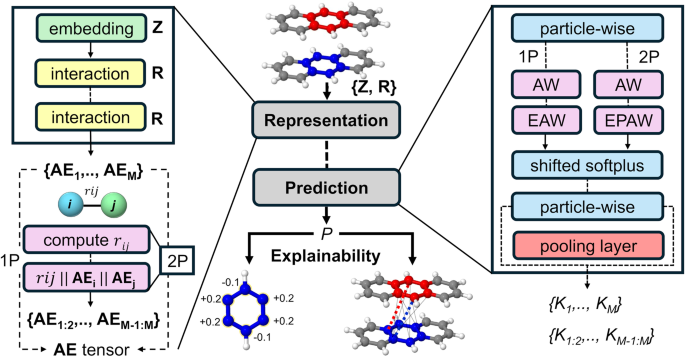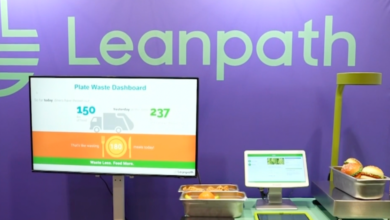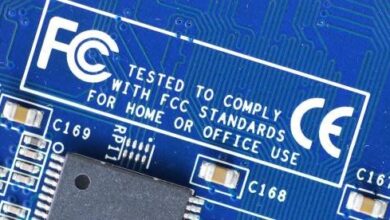Explainable chemical artificial intelligence from accurate machine learning of real-space chemical descriptors

Jung, J. et al. New parallel computing algorithm of molecular dynamics for extremely huge scale biological systems. J. Comput. Chem. 42, 231–241 (2021).
Singh, V., Patra, S., Murugan, N. A., Toncu, D.-C. & Tiwari, A. Recent trends in computational tools and data-driven modeling for advanced materials. Mater. Adv. 3, 4069–4087 (2022).
Vogiatzis, K. D. et al. Computational approach to molecular catalysis by 3d transition metals: challenges and opportunities. Chem. Rev. 119, 2453–2523 (2019).
Cembran, A., Bernardi, F., Olivucci, M. & Garavelli, M. Counterion controlled photoisomerization of retinal chromophore models: a computational investigation. J. Am. Chem. Soc. 126, 16018–16037 (2004).
Vermeeren, P. et al. Pericyclic reaction benchmarks: hierarchical computations targeting ccsdt(q)/cbs and analysis of dft performance. Phys. Chem. Chem. Phys. 24, 18028–18042 (2022).
Martín Pendás, A. et al. Atoms in molecules in real space: a fertile field for chemical bonding. Phys. Chem. Chem. Phys. 25, 10231–10262 (2023).
Coulson, C. A. Present state of molecular structure calculations. Rev. Mod. Phys. 32, 170–177 (1960).
Popelier, P. L. A. On quantum chemical topology. In Challenges and Advances in Computational Chemistry and Physics, 23–52 (Switzerland, Springer International Publishing, 2016).
Jeziorski, B., Moszynski, R. & Szalewicz, K. Perturbation theory approach to intermolecular potential energy surfaces of van der waals complexes. Chem. Rev. 94, 1887–1930 (1994).
Cohen, M. H. & Wasserman, A. On the foundations of chemical reactivity theory. J. Phys. Chem. A 111, 2229–2242 (2007).
Elliott, P., Burke, K., Cohen, M. H. & Wasserman, A. Partition density-functional theory. Phys. Rev. A 82, 024501 (2010).
Bader, R. Atoms in Molecules: A Quantum Theory. International Series of Monographs on Chemistry (Oxford University Press, Oxford, 1990).
Francisco, E., Martín Pendás, A. & Blanco, M. Edf: computing electron number probability distribution functions in real space from molecular wave functions. Comput. Phys. Commun. 178, 621–634 (2008).
Blanco, M. A., Martín Pendás, A. & Francisco, E. Interacting quantum atoms: a correlated energy decomposition scheme based on the quantum theory of atoms in molecules. J. Chem. Theory Comput. 1, 1096–1109 (2005).
Zhao, L., von Hopffgarten, M., Andrada, D. M. & Frenking, G. Energy decomposition analysis. Wiley Interdiscip. Rev. Comput. Mol. Sci. 8, 1345 (2018).
van Zeist, W.-J. & Bickelhaupt, F. M. The activation strain model of chemical reactivity. Org. Biomol. Chem. 8, 3118–3127 (2010).
Guevara-Vela, J. M., Francisco, E., Rocha-Rinza, T. & Martín Pendás, A. Interacting quantum atoms—a review. Molecules 25, 4028 (2020).
Jiménez-Grávalos, F., Díaz, N., Francisco, E., Pendás, Á. M. & Suárez, D. Interacting quantum atoms approach and electrostatic solvation energy: assessing atomic and group solvation contributions. ChemPhysChem 19, 3425–3435 (2018).
López, R., Díaz, N., Francisco, E., Martín Pendás, A. & Suárez, D. QM/MM energy decomposition using the interacting quantum atoms approach. J. Chem. Inf. Model. 62, 1510–1524 (2022).
Martín Pendás, A., Francisco, E. & Blanco, M. A. Two-electron integrations in the quantum theory of atoms in molecules with correlated wave functions. J. Comput. Chem. 26, 344–351 (2005).
Rodríguez, J. I., Cortés-Guzmán, F. & Anderson, J. S. M. (eds.) Advances in Quantum Chemical Topology Beyond QTAIM (Elsevier—Health Sciences Division, Philadelphia, PA, 2022).
Baum, Z. J. et al. Artificial intelligence in chemistry: Current trends and future directions. J. Chem. Inf. Model. 61, 3197–3212 (2021).
Sajjan, M. et al. Quantum machine learning for chemistry and physics. Chem. Soc. Rev. 51, 6475–6573 (2022).
Keith, J. A. et al. Combining machine learning and computational chemistry for predictive insights into chemical systems. Chem. Rev. 121, 9816–9872 (2021).
Gasteiger, J. Chemistry in times of artificial intelligence. ChemPhysChem 21, 2233–2242 (2020).
Jumper, J. et al. Highly accurate protein structure prediction with alphafold. Nature 596, 583–589 (2021).
Zielinski, F. et al. Geometry optimization with machine trained topological atoms. Sci. Rep. 7, 12817–12817 (2017).
Jussupow, A. & Kaila, V. R. I. Effective molecular dynamics from neural network-based structure prediction models. J. Chem. Theory Comput. 19, 1965–1975 (2023).
Mills, A. W., Goings, J. J., Beck, D., Yang, C. & Li, X. Exploring potential energy surfaces using reinforcement machine learning. J. Chem. Inf. Model. 62, 3169–3179 (2022).
Lu, F. et al. Fast near ab initio potential energy surfaces using machine learning. J. Phys. Chem. A 126, 4013–4024 (2022).
Schienbein, P. Spectroscopy from machine learning by accurately representing the atomic polar tensor. J. Chem. Theory Comput. 19, 705–712 (2023).
Ponting, D. J., van Deursen, R. & Ott, M. A. Machine learning predicts degree of aromaticity from structural fingerprints. J. Chem. Inf. Model. 60, 4560–4568 (2020).
Acosta, C. M., Ogoshi, E., Souza, J. A. & Dalpian, G. M. Machine learning study of the magnetic ordering in 2d materials. ACS Appl. Mater. Interfaces. 14, 9418–9432 (2022).
Malakar, P., Thakur, M. S. H., Nahid, S. M. & Islam, M. M. Data-driven machine learning to predict mechanical properties of monolayer transition-metal dichalcogenides for applications in flexible electronics. ACS Appl. Nano Mater. 5, 16489–16499 (2022).
Lee, B. K. et al. A principal odor map unifies diverse tasks in olfactory perception. Science 381, 999–1006 (2023).
Jiménez-Luna, J., Grisoni, F. & Schneider, G. Drug discovery with explainable artificial intelligence. Nat. Mach. Intell. 2, 573–584 (2020).
Jain, A. et al. Commentary: the materials project: a materials genome approach to accelerating materials innovation. APL Mater. 1, 011002 (2013).
Symons, B. C. B., Bane, M. K. & Popelier, P. L. A. Dl_fflux: a parallel, quantum chemical topology force field. J. Chem. Theory Comput. 17, 7043–7055 (2021).
McDonagh, J. L., Silva, A. F., Vincent, M. A. & Popelier, P. L. A. Machine learning of dynamic electron correlation energies from topological atoms. J. Chem. Theory Comput. 14, 216–224 (2018).
Symons, B. C. B. & Popelier, P. L. A. Application of quantum chemical topology force field flux to condensed matter simulations: Liquid water. J. Chem. Theory Comput. 18, 5577–5588 (2022).
Hawe, G. I. & Popelier, P. L. A water potential based on multipole moments trained by machine learning—reducing maximum energy errors. Can. J. Chem. 88, 1104–1111 (2010).
Maxwell, P., di Pasquale, N., Cardamone, S. & Popelier, P. L. A. The prediction of topologically partitioned intra-atomic and inter-atomic energies by the machine learning method kriging. Theor. Chem. Acc. 135, 195 (2016).
Handley, C. M. & Popelier, P. L. A. Dynamically polarizable water potential based on multipole moments trained by machine learning. J. Chem. Theory Comput. 5, 1474–1489 (2009).
Gallegos, M., Guevara-Vela, J. M. & Martín Pendás, A. NNAIMQ: a neural network model for predicting QTAIM charges. J. Chem. Phys. 156, 014112 (2022).
Oviedo, F., Ferres, J. L., Buonassisi, T. & Butler, K. T. Interpretable and explainable machine learning for materials science and chemistry. Acc. Mater. Res. 3, 597–607 (2022).
Faroughi, S. A. et al. Physics-guided, physics-informed, and physics-encoded neural networks in scientific computing: fluid and solid mechanics. J. Comput. Inf. Sci. Eng. 24, 040802 (2024).
Jiménez-Luna, J., Skalic, M., Weskamp, N. & Schneider, G. Coloring molecules with explainable artificial intelligence for preclinical relevance assessment. J. Chem. Inf. Model. 61, 1083–1094 (2021).
Tjoa, E. & Guan, C. A survey on explainable artificial intelligence (XAI): toward medical XAI. IEEE Trans. Neural Netw. Learn. Syst. 32, 4793–4813 (2021).
Guidotti, R. et al. A survey of methods for explaining black box models. ACM Comput. Surv. 51, 1–42 (2018).
Schütt, K. et al. Schnet: a continuous-filter convolutional neural network for modeling quantum interactions. In (eds Guyon, I. et al.) Advances in Neural Information Processing Systems, vol. 30 (Curran Associates, Inc., 2017).
Schütt, K. T., Sauceda, H. E., Kindermans, P.-J., Tkatchenko, A. & Müller, K.-R. Schnet—a deep learning architecture for molecules and materials. J. Chem. Phys. 148, 241722 (2018).
Schütt, K. T. et al. Schnetpack: a deep learning toolbox for atomistic systems. J. Chem. Theory Comput. 15, 448–455 (2019).
Westermayr, J. & Maurer, R. J. Physically inspired deep learning of molecular excitations and photoemission spectra. Chem. Sci. 12, 10755–10764 (2021).
Ward, L. et al. Machine learning prediction of accurate atomization energies of organic molecules from low-fidelity quantum chemical calculations. MRS Commun. 9, 891–899 (2019).
Gao, P., Zhang, J., Sun, Y. & Yu, J. Accurate predictions of aqueous solubility of drug molecules via the multilevel graph convolutional network (MGCN) and SchNet architectures. Phys. Chem. Chem. Phys. 22, 23766–23772 (2020).
Erlebach, A., Nachtigall, P. & Grajciar, L. Accurate large-scale simulations of siliceous zeolites by neural network potentials. Npj Comput. Mater. 8, 1–12 (2022).
Zhang, J., Chen, J., Hu, P. & Wang, H. Identifying the composition and atomic distribution of pt-au bimetallic nanoparticle with machine learning and genetic algorithm. Chin. Chem. Lett. 31, 890–896 (2020).
Westermayr, J., Gastegger, M. & Marquetand, P. Combining SchNet and SHARC: the SchNarc machine learning approach for excited-state dynamics. J. Phys. Chem. Lett. 11, 3828–3834 (2020).
Timm, M. J., Matta, C. F., Massa, L. & Huang, L. The localization–delocalization matrix and the electron-density-weighted connectivity matrix of a finite graphene nanoribbon reconstructed from kernel fragments. J. Phys. Chem. A 118, 11304–11316 (2014).
Sumar, I., Ayers, P. W., Cook, R. & Matta, C. F. Aromaticity of rings-in-molecules (rims) from electron localization–delocalization matrices (ldms)*. Phys. Scr. 91, 013001 (2015).
Sumar, I., Ayers, P. W. & Matta, C. F. Electron localization-delocalization matrices in the prediction of pka’s and uv-wavelengths of maximum absorbance of p-benzoic acids and the definition of super-atoms in molecules. Chem. Phys. Lett. 612, 190–197 (2014).
Rafat, M., Shaik, M. & Popelier, P. L. A. Transferability of quantum topological atoms in terms of electrostatic interaction energy. J. Phys. Chem. A 110, 13578–13583 (2006).
Silva, A. F., Vincent, M. A., McDonagh, J. L. & Popelier, P. L. A. The transferability of topologically partitioned electron correlation energies in water clusters. ChemPhysChem 18, 3360–3368 (2017).
Lefrancois-Gagnon, K. M. & Mawhinney, R. C. Toward universal substituent constants: transferability of group descriptors from the quantum theory of atoms in molecules. J. Comput. Chem. 43, 265–278 (2022).
Mooij, W. T. M., van Eijck, B. P. & Kroon, J. Transferable ab initio intermolecular potentials. 2. Validation and application to crystal structure prediction. J. Phys. Chem. A 103, 9883–9890 (1999).
Grabowsky, S. et al. Transferability and reproducibility in electron-density studies bond-topological and atomic properties of tripeptides of the type l-alanyl-x-l-alanine. Acta. Crystallogr. B. Struct. Sci. Cryst. 65, 488–501 (2009).
Maxwell, P. & Popelier, P. L. Transferable atoms: an intra-atomic perspective through the study of homogeneous oligopeptides. Mol. Phys. 114, 1304–1316 (2015).
Ferro-Costas, D., Francisco, E., Martín Pendás, A. & Mosquera, R. A. How electronic excitation can be used to inhibit some mechanisms associated to substituent effects. ChemPhysChem 17, 2666–2671 (2016).
Vila, A. & Mosquera, R. A. Transferability in alkyl monoethers. II. Methyl and methylene fragments. J. Chem. Phys. 115, 1264–1273 (2001).
Rykounov, A. A. & Tsirelson, V. G. Quantitative estimates of transferability of the QTAIM descriptors. case study of the substituted hydropyrimidines. J. Mol. Struct. 906, 11–24 (2009).
Yuan, Y., Mills, M. J. L., Popelier, P. L. A. & Jensen, F. Comprehensive analysis of energy minima of the 20 natural amino acids. J. Phys. Chem. A 118, 7876–7891 (2014).
Hymel, J. H., Townsend, J. & Vogiatzis, K. D. Co2 capture on functionalized calixarenes: a computational study. J. Phys. Chem. A 123, 10116–10122 (2019).
Sansone, F., Baldini, L., Casnati, A. & Ungaro, R. Calixarenes: from biomimetic receptors to multivalent ligands for biomolecular recognition. New J. Chem. 34, 2715–2728 (2010).
Blazejczyk, A. et al. Anion-binding calixarene receptors: synthesis, microstructure, and effect on properties of polyether electrolytes. Chem. Mater. 17, 1535–1547 (2005).
Kumar, R. et al. Revisiting fluorescent calixarenes: from molecular sensors to smart materials. Chem. Rev. 119, 9657–9721 (2019).
Español, E. & Villamil, M. Calixarenes: generalities and their role in improving the solubility, biocompatibility, stability, bioavailability, detection, and transport of biomolecules. Biomolecules 9, 90 (2019).
Zhou, Y., Li, H. & Yang, Y.-W. Controlled drug delivery systems based on calixarenes. Chin. Chem. Lett. 26, 825–828 (2015).
Sreedevi, P. et al. Calix[4]arene based redox sensitive molecular probe for SERS guided recognition of labile iron pool in tumor cells. Anal. Chem. 90, 7148–7153 (2018).
Durmaz, M., Halay, E. & Bozkurt, S. Recent applications of chiral calixarenes in asymmetric catalysis. Beilstein J. Org. Chem. 14, 1389–1412 (2018).
Guo, D.-S., Uzunova, V. D., Su, X., Liu, Y. & Nau, W. M. Operational calixarene-based fluorescent sensing systems for choline and acetylcholine and their application to enzymatic reactions. Chem. Sci. 2, 1722–1734 (2011).
Montà-González, G., Sancenón, F., Martínez-Máñez, R. & Martí-Centelles, V. Purely covalent molecular cages and containers for guest encapsulation. Chem. Rev. 122, 13636–13708 (2022).
Davis, F., Higson, S. P. J., Oliveira, O. N. & Shimizu, F. M. Calixarene-based gas sensors. In Materials Horizons: From Nature to Nanomaterials, 433–462 (Springer Singapore, 2020).
Filenko, D. et al. Chemical gas sensors based on calixarene-coated discontinuous gold films. Sens. Actuators B 111, 264–270 (2005).
Kumar, S., Chawla, S. & Zou, M. C. Calixarenes based materials for gas sensing applications: a review. J. Incl. Phenom. Macrocycl. Chem. 88, 129–158 (2017).
Cram, D. J., Tanner, M. E. & Knobler, C. B. Host-guest complexation. 58. Guest release and capture by hemicarcerands introduces the phenomenon of constrictive binding. J. Am. Chem. Soc. 113, 7717–7727 (1991).
Yao, C.-Y. & de Silva, A. P. Recent developments in CO2 capture/storage/utilization with aromatic macrocycles. Carbon Capture Sci. Technol. 4, 100058 (2022).
Taghizadeh, F., Mokhtarani, B., Zadmard, R. & Jalali, M. R. Highly selective CO2 uptake in calix[4]arene compounds immobilized on silica gel. Chem. Eng. J. 417, 128115 (2021).
Shi, J.-W. et al. Calixarene-functionalized stable bismuth oxygen clusters for specific CO2-to-hcooh electroreduction. ACS Catal. 12, 14436–14444 (2022).
Tsue, H. et al. Crystallographic analysis of CO2 sorption state in seemingly nonporous molecular crystal of azacalix[4]arene tetramethyl ether exhibiting highly selective co2 uptake. CrystEngComm 14, 1021–1026 (2012).
Wu, W. et al. Design of calix-based cages for CO2 capture. Ind. Eng. Chem. Res. 56, 4502–4507 (2017).
Baldini, L. et al. CO2 capture by multivalent amino-functionalized calix[4]arenes: self-assembly, absorption, and qcm detection studies. J. Org. Chem. 76, 3720–3732 (2011).
Kato, T. On the eigenfunctions of many-particle systems in quantum mechanics. Commun. Pure Appl. Math. 10, 151–177 (1957).
Pembere, A. M. S., Liu, X., Ding, W. & Luo, Z. How partial atomic charges and bonding orbitals affect the reactivity of aluminum clusters with water? J. Phys. Chem. A 122, 3107–3114 (2018).
Iwaoka, M., Komatsu, H., Katsuda, T. & Tomoda, S. Nature of nonbonded se-o interactions characterized by 17O NMR spectroscopy and NBO and AIM analyses. J. Am. Chem. Soc. 126, 5309–5317 (2004).
Geidl, S. et al. High-quality and universal empirical atomic charges for chemoinformatics applications. J. Cheminform. 7, 59 (2015).
Outeiral, C., Vincent, M. A., Martín Pendás, A. & Popelier, P. L. A. Revitalizing the concept of bond order through delocalization measures in real space. Chem. Sci. 9, 5517–5529 (2018).
Wiberg, K. Application of the pople-santry-segal CNDO method to the cyclopropylcarbinyl and cyclobutyl cation and to bicyclobutane. Tetrahedron 24, 1083–1096 (1968).
Mayer, I. Charge, bond order and valence in the AB initio SCF theory. Chem. Phys. Lett. 97, 270–274 (1983).
Francisco, E., Martín Pendás, A., García-Revilla, M. & Boto, R. Á. A hierarchy of chemical bonding indices in real space from reduced density matrices and cumulants. Comput. Theor. Chem. 1003, 71–78 (2013).
Maheshwary, S., Patel, N., Sathyamurthy, N., Kulkarni, A. D. & Gadre, S. R. Structure and stability of water clusters (h2o)n, n = 8-20: An ab initio investigation. J. Phys. Chem. A 105, 10525–10537 (2001).
Neese, F., Wennmohs, F., Becker, U. & Riplinger, C. The orca quantum chemistry program package. J. Chem. Phys. 152, 224108 (2020).
Jmol: an open-source java viewer for chemical structures in 3d. http://www.jmol.org/.
Miguel Gallegos. Schnet4aim-data, mendeley data, v1. https://doi.org/10.17632/8f9g79pcvj.1, https://data.mendeley.com/datasets/8f9g79pcvj/1 (2024).
Gallegos, M. Explainable chemical artificial intelligence: Accurate machine learning of real-space chemical descriptors. https://github.com/m-gallegos/SchNet4AIM (2024). SchNet4AIM. https://doi.org/10.5281/zenodo.10802320.
Frisch, M. J. et al. Gaussian 09 Revision E.01. (Gaussian Inc., Wallingford CT, 2009).
Martín Pendás, A. & Francisco, E. Promolden. a qtaim/iqa code (avaliable from the authors upon request).
Keith, T. A. Aimall, tk gristmill software, overland park, KS, USA (2019).



